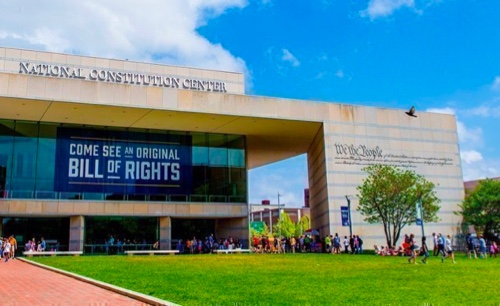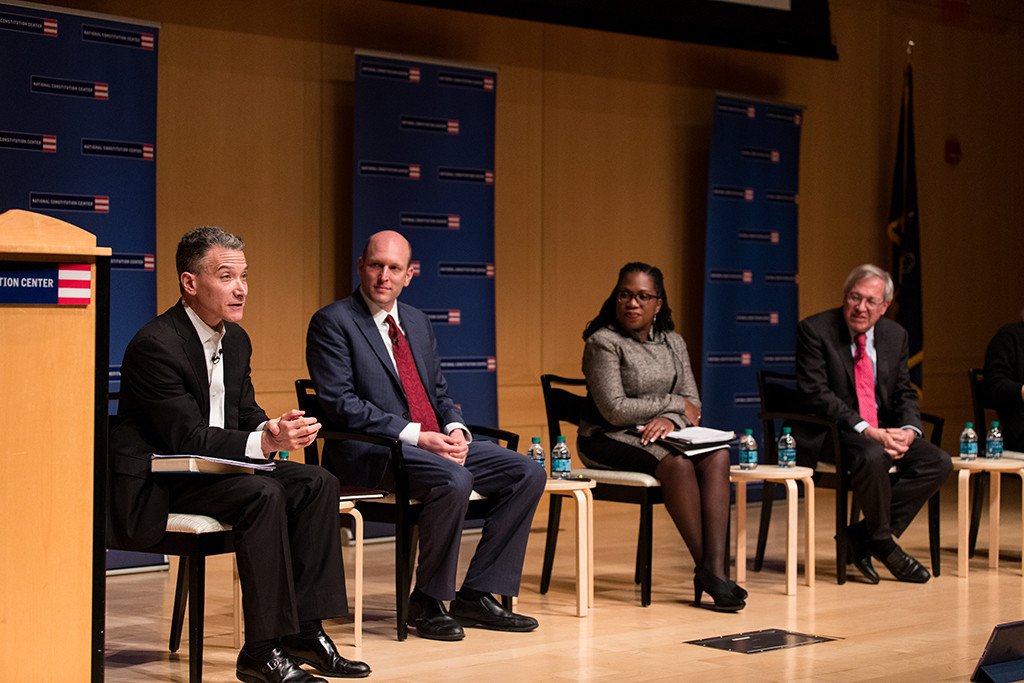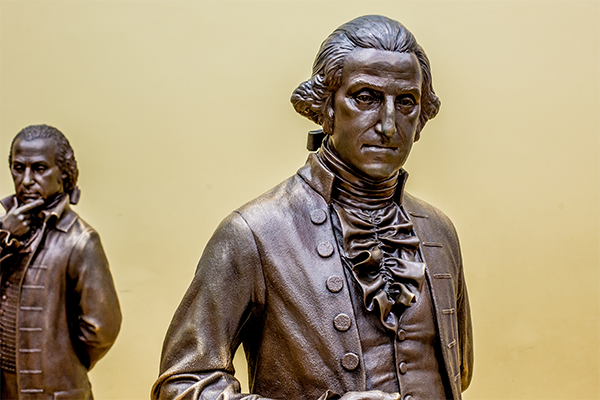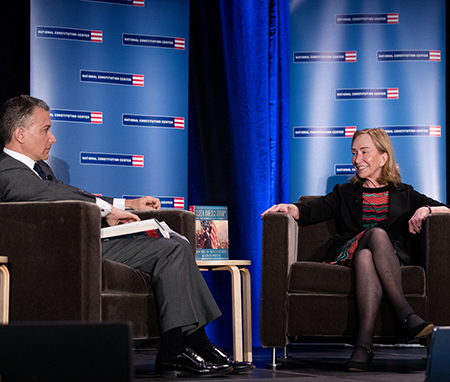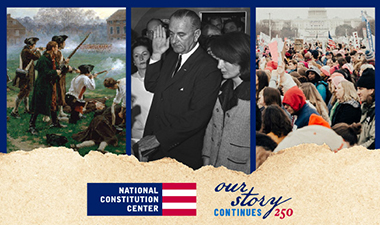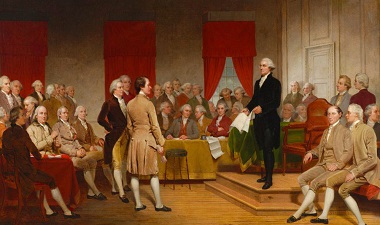In this episode, Jess Bravin of The Wall Street Journal, Jan Crawford of CBS News, and Fred Smith Jr. of Stanford Law School join to explore polarization on the Court and the role of the media and the political branches in shaping public perceptions.
Please follow We the People and Live at the National Constitution Center on Apple Podcasts, Spotify, or your favorite podcast app.
Today’s episode was produced by Bill Pollock, and Griffin Richie. It was engineered by Dave Stotz, Greg Scheckler, and Bill Pollock. Research was provided by Gyuha Lee, Griffin Richie, Cooper Smith, Trey Sullivan, and Tristan Worsham.
Participants
Jess Bravin is a Supreme Court correspondent for The Wall Street Journal. He is the author of several books, including The Terror Courts, an account of military trials at Guantanamo Bay.
Jan Crawford is CBS News’ chief legal correspondent. Her 2007 book, Supreme Conflict: The Inside Story of the Struggle for the Control of the United States Supreme Court, gained critical acclaim and became an instant New York Times bestseller.
Fred Smith Jr. is a professor of law at Stanford Law School specializing in the federal judiciary, constitutional law, and posthumous legal interests. His work has appeared in several prestigious academic journals and he has been interviewed as an expert by major media outlets.
Jeffrey Rosen is the president and CEO of the National Constitution Center, a nonpartisan nonprofit organization devoted to educating the public about the U.S. Constitution. He is also professor of law at the George Washington University Law School and a contributing editor of The Atlantic.
Additional Resources
- Trump v. CASA, Inc. (2025)
- Jess Bravin and Mariah Timms, “Supreme Court Limits Rulings Against Trump on Birthright Citizenship,” The Wall Street Journal (June 27, 2025)
- Jan Crawford, Supreme Conflict: The Inside Story of the Struggle for the Control of the United States Supreme Court (2007)
- Fred O. Smith, Jr. and Peter O’Neill, “The Forgotten Face of ‘Our Federalism,’” The Yale Law Journal (forthcoming, 2026)
Excerpt from interview: Fred Smith Jr. describes teaching his students to understand the law without cynicism and emphasizes that press coverage has influenced the Court’s institutional practices, reflecting a constructive dialogue between the media and the Court.
Fred Smith Jr.: Well, in terms of how I teach my students, my view is that my job is just to teach the law and to help them understand it the best that I can. And I find that I've taught for 15 years, and I found that students' relationship to the Court isn't really linear. It doesn't just go like this, and it doesn't just go like that. It actually, at different moments, students have different kind of reactions. And I think I do have a job of making sure that cynicism doesn't cloud their ability to understand the law. And what that looks like in different moments kind of shifts, because the importance is understanding. That's what I see my job as. I do want to answer the question of just kind of what the press coverage has meant for the Court's own actions. And then I promise I'll end with something optimistic in saying so. I think it has affected some of their institutional practices, right? And we've heard about some of them. I think the relationship to the emergency docket, yes, we don't have nearly enough opinions, but we have more than we used to. We don't have enough oral argument, but we have more than we used to.
There used to be none. And I think it's hard to understand that institutional change without appreciating the critiques that the Court was facing, and it listened. Some of the critiques around disclosures resulted in the Supreme Court adopting. It's an ethics policy. Again, many people think it doesn't go far enough, but it's more than they had before, right? And so that's an example, too, of there being dialogue between the fourth estate and the Supreme Court. So that's the most optimistic statement that I can end on.
Excerpt from interview: Jan Crawford reflects on how technological advancements and pivotal events have transformed and politicized Supreme Court coverage, arguing that the resulting portrayal of the Court as partisan is both false and harmful.
Jan Crawford: No. I think obviously there's been tremendous change. I started covering the court in 1994. And like Jess said, I mean, we wouldn't get argument transcripts for 10 to 15 days. Now you get them within the hour. And so when we would go in the press room after an argument, because we all had to attend because there were no live audio, you had to be there to know what was happening. We would literally, and we were competitors, but we wanted to get it right. So we would compare notes like, wait, did the chief justice say that or who said that? So that we could really have this understanding of what the court was doing so we could better explain it to people. I was with the Chicago Tribune then, but who people were reading back home who couldn't be in the court listening to those arguments. Obviously now that's all changed. We have live audio. That only started in 2000 with Bush v. Gore and only for very few cases. And I will tell you this Bush v. Gore, that was reported on cassette tapes. And so they ran that out to the satellite truck that was doing the feed after the argument concluded and they started the playback.
So now we have live instantaneous audio transmission. So it's been, and filings, those are all online. Like Jess said, you used to have to go into the press room and request the briefs. They were all in paper. I mean, I know I'm like sound like some old, we didn't go to horse and buggy them, but you know, whatever. It was pretty close. I don't think we had cell phones then either. But at any rate, you know, so all this technology has meant it's tremendous. I mean, it's opened the court up in ways that people can now listen to the Court. They can have a greater understanding of the Court. They can get more engaged in what the Court is doing. It's also led to new mediums, different people who cover the Court. And I don't think, and that's where I think we've seen the biggest change, setting aside the composition of the Court, the tools and how people do it and technology. The biggest change is how the Court’s covered. And I do not believe that it is necessarily for the better. It is covered as a political institution because most of the people disagree with the outcome.
They decided, I mean, this started when, I guess, when Senator McConnell refused to fill Scalia's seat and kept that open. There was tremendous rage there, but we really saw the turning point after the leak of the Dobbs decision, which overturned Roe v. Wade. And, you know, we really started seeing this drumbeat of that the Court's a political institution, that it's corrupt. I mean, if you believe everything you read, you're going to think the Court is corrupt, lawless, beholden to Trump, driven by politics. All of that is patently false. It's not true. These are justices who have very different views on the law. They're engaged in this titanic struggle over their ideologies. They're not corrupt. They're not in the tank for Trump. I mean, I, you know, I'll leave it at that. But, you know, they're up there. They're nine really engaged, smart people trying to figure out what the right answers are. These are hard cases. They typically take cases that have divided the really smart people on the lower courts. And so they have to figure out what's the answer. And that's always what I look at when the decision comes down.
But when you put this narrative out there that, you know, you've got your thumb on the scale, that doesn't serve anyone. That, in fact, hurts the Court and its view and how people view it as an institution.
Excerpt from interview: Jess Bravin reflects on how media coverage and public criticism may influence the Court, arguing that while the justices are aware of external commentary, their insulated environments and the opacity of internal decision-making keep them largely impervious to outside pressure.
Jess Bravin: I think the Supreme Court members have a bifurcated view of these things. I think they simultaneously don't care at all about the coverage of the Court, and they also care intensely about it at the same time. They don't believe they're influenced by it, but from offhand comments, I'd say they read a lot. They're very familiar with podcasts and blogs and they're interested in what people are saying about them, whether that affects what they do. We don't know, but there was a lot of criticism from the right wing of Justice Barrett earlier in this term when she cast a number of votes that went against the Trump administration's interest. And I know that we've seen some people, some of the people in the exosphere or whatever it's called, claiming some responsibility for helping her get back on the right path in more recent decisions.
Now, I doubt that she believes that that's what's going on, but there is this question of how much does the reflected view of themselves affect what the justices do? The Court in some ways has made itself more transparent in that they have now live transmission of arguments and the briefs and opinions are posted immediately and there's more opportunity for people to see the product of the Court, but there is certainly no more insight into how the Court is producing that material, especially on the emergency docket, except for the occasional, too occasional in my view, leak of drafts or internal discussions of what's going on. I wish we could say more clearly whether, I mean, the court keeps its distance from most journalists, as you know, more than some former members did, I think, and that is because they are more distrustful of the media. I think that the leak of the Dobbs opinion caused things to get tighter around the Supreme Court in a number of ways. It also caused a lot of news organizations to treat the court more like a political institution and cover it more like a political institution and look at the personal relationships of the justices, look at potential conflicts of interest, look at who they're talking to being influenced by more like they cover political officials.
And I don't think the Court likes that and that increases their own cynicism about the way they are being covered. But ultimately, though, all of them pretty much live in a bubble where they're surrounded by people who tell them how brilliant they are and how correct their views are and seek to help them attain the results they are after. They don't, I think, apart from their colleagues who certainly do criticize them, they do have different opinions, but the world that they inhabit in the Supreme Court building and the places they choose to go generally is very favorable to each of the justices. I mean, they select where they go and that tends to be where they go. If you ever look at an interview when a justice gives, whether it's about a book that has come out or they're visiting a judicial conference or law school, usually the interviewer is someone who is very sympathetic and doesn't ask the kinds of questions that Jan would ask if she had the opportunity to do it. And therefore, I don't know that the justices take very, very seriously a lot of the criticism that appears in the press.
Full Transcript
View Transcript (PDF)
This transcript may not be in its final form, accuracy may vary, and it may be updated or revised in the future.
Stay Connected and Learn More
- Questions or comments about the show? Email us at [email protected]
- Continue the conversation by following us on social media @ConstitutionCtr
- Explore the America at 250 Civic Toolkit
- Sign up to receive Constitution Weekly, our email roundup of constitutional news and debate
- Subscribe, rate, and review wherever you listen
- Join us for an upcoming live program or watch recordings on YouTube
- Support our important work
